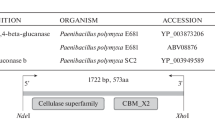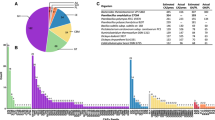Abstract
A cyanobacterial strain (Anabaena laxa RPAN8) exhibiting fungicidal activity and β-1,3 and 1,4 endoglucanase activities was selected for identifying the gene(s) involved. Functional analyses of the genomic library revealed that four clones (8, 64, 116, and 248) of RPAN8 exhibited fungicidal activity and induced structural deformities in the cell wall of the growing mycelia of Pythium aphanidermatum. Higher expression of fungicidal and β-1,4 endoglucanase activities, along with low expression of β-1,3 endoglucanase activity, was recorded in two E. coli clones (8 and 64). Clones 8 and 64 exhibited identical sequences while clones 116 and 248 were also similar. Bioinformatic analyses were undertaken only for the two non-identical clones 8 and 116 which showed open reading frames (ORFs) of 348 (end 1) and 656 amino acid residues (end 2), respectively. The amino acid sequence analyses revealed that the end 1 encoding endoglucanases belonged to peptidase M20 family while end 2 showed significant similarities with several known genes. The putative promoters and ribosomal binding sites were identified and amino acid exchanges were observed in both end 1 and 2. The presence of signal peptides of 24 and 20 amino acid residues respectively revealed the secretory nature of these proteins.


Similar content being viewed by others
References
Altschul SF, Gish W, Mille W, Meyers EW, Lipman DJ (1990) Basic local alignment search tool. J Mol Biol 215:403–410
Beguin P, Millet J, Chauvaux S, Salamitou S, Tokatlidis K, Navas J, Fujino T, Lemaire M, Raynaud O, Daniel MK, Aubert JP (1992) Bacterial cellulases. Biochem Soc Trans 20:42–46
Bendtsen JD, Neilsen H, Heijne GV, Brunak S (2004) Improved prediction of signal peptides: SignalP 3.0. J Mol Biol 340:783–795
Chang BY, Shyu YT, Doi RH (1992) The interaction between Bacillus subtilis sigma-A factor and RNA polymerase with promoters. Biochimie 74:601–612
Chang WT, Chen YC, Jao CL (2007) Fungicidal activity and enhancement of plant growth by Bacillus cereus grown on shellfish chitin wastes. Biores Technol 98:1224–1230
Choi YJ, Kim EJ, Piao Z, Yun YC, Shin YC (2004) Purification and characterization of chitosanase from Bacillus sp. strain KCTC 0377BP and its application for the production of chitosan oligosaccharides. Appl Environ Microbiol 70:4522–4531
Coutinho PM, Henrisaat B (1999) Carbohydrate-active enzymes: an integrated database approach. In: Gilbert HJ, Davies GJ, Henrisaat B, Svensson B (eds) Recent advances in carbohydrate bioengineering. The Royal Society of Chemistry, Cambridge, pp 3–12
Endo Y, Yokoyama M, Morimoto M, Shirai K, Chikamatsu G, Kato N, Tsukagoshi N, Kato M, Kobayashi T (2008) Novel promoter sequence required for inductive expression of the Aspergillus nidulans endoglucanase gene eglA. Biosci Biotechnol Biochem 72:312–320
Gao XA, Ju WT, Jung WJ, Park RD (2007) Purification and characterization of chitosanase from Bacillus cereus D-11. Carbohydr Polym 72:513–520
Geelen D, Montagu VM, Holsters M (1995) Cloning of an Azorhizobium caulinodans endoglucanase gene and analysis of its role in symbiosis. Appl Environ Microbiol 61:3304–3310
Ghosh TK, Bailey HJ, Bisaria VS, Enari TM (1983) Measurement of cellulase activity. In: International union of pure and applied chemistry commission of biotechnology. Final recommendation, pp 1–13
Han SO, Yukawa H, Inui M, Doi RH (2003) Transcription of Clostridium cellulovorans cellulosomal cellulase and hemicellulase genes. J Bacteriol 185:2520–2527
Harley CB, Reynolds RP (1987) Analysis of E. coli promoter sequences. Nucleic Acids Res 15:2343–2361
Hara Y, Hinoki Y, Shimoi H, Ito K (2003) Cloning and sequence analysis of endoglucanase genes from an industrial fungus, Aspergillus kawachii. Biosci Biotechnol Biochem 67:2010–2013
Hedges A, Wolfe RS (1974) Extracellular enzyme from Myxcobacter AL-1 that exhibits both β-1, 4-glucanase and chitosanase activities. J Bacteriol 120:844–853
Henrissat B, Driguez H, Viet C, Schulein M (1985) Synergism of cellulases from Trichoderma reesei in the degradation of cellulose. Biotechnol 3:722–726
Henrissat B, Claeyssens M, Tomme P, Lemesle L, Mornon JP (1989) Cellulase families revealed by hydrophobic cluster analysis. Gene 81:83–95
Hill TW, Loprete DM, Kim NV, Mokhtari SPB, Hardin LV (2002) Proteolytic release of membrane-bound endo-(1, 4)-β-glucanase activity associated with cell wall softening in Achlya ambisexualis. Can J Microbiol 48:93–98
Hong IP, Jang HK, Lee SY, Choi SG (2003) Clone and characterization of a bifunctional cellulase-chitosanase gene from Bacillus licheniformis NBL420. J Microbiol Biotechnol 13:35–42
Ike M, Ko Y, Yokoyama K, Sumitani JI, Kawaguchi T, Ogasawara W, Okada H, Morikawa Y (2007) Cellobiohydrolase I (Cel7A) from Trichoderma reesei has chitosanase activity. J Mol Cat B: Enzymatic 47:159–163
Inoue T, Murashima K, Azuma J, Sugimoto A, Slaytor M (1997) Cellulose and xylan utilization in the lower termite Reticulitermes speratus. J Insect Physiol 43:235–242
Jaiswal P, Prasanna R, Singh PK (2008) Cyanobacterial bioactive molecules—an overview of their “cidal” properties. Can J Microbiol 54:701–717
Kaushik BD (1987) Laboratory methods for blue green algae. Associated Publishing, New Delhi
Kimoto H, Kusaoke H, Yamamoto I, Fujii Y, Onodera T, Taketo A (2002) Biochemical and genetic properties of Paenibacillus glycosyl hydrolase having chitosanase activity and discoidin domain. J Biol Chem 277:14695–14702
Kurakake M, Yo-u S, Nakagawa K, Sugihara M, Komaki T (2000) Properties of chitosanase from Bacillus cereus S1. Curr Microbiol 40:6–9
Larkin MA, Blackshields G, Brown NP, Chenna R, McGettigan PA, McWilliam H, Valentin F, Wallace IM, Wilm A (2007) ClustalW and ClustalX version 2. Bioinformatics 23:2947–2948
Ledger TN, Jaubert S, Bosselut N, Abad P, Rosso MN (2006) Characterization of a new β-1, 4-endoglucanase gene from the root-knot nematode Meloidogyne incognita and evolutionary scheme for phytonematode family 5 glycosyl hydrolases. Gene 382:121–128
Lima AOS, Quecine MC, Fungaro MHP, Andreote FD, Maccheroni JW, Araujo WL, Silva-Filho MC, Pizzirani-Kleiner AA, Azevedo JL (2005) Molecular characterization of a β-1, 4-endoglucanase from a endophytic Bacillus pumilus strain. Appl Microbiol Biotechnol 68:57–65
Liu J, Xia WS (2005) Characterization of chitosanase from cellulase produced by Trichoderma viride. Chinese J Biochem Mol Biol 21:713–716
Liu J, Xia WS (2006) Purification and characterization of a bifunctional enzyme with chitosanase and cellulase activity from commercial cellulase. Biochem Eng J 30:82–87
Loprete DM, Hill TW (2002) Isolation and characterization of an endo-(1, 4)-β-glucanase secreted by Achlya ambisexualis. Mycologia 94:908–911
Manjunath M, Prasanna R, Lata N, Dureja P, Singh R, Kumar A, Jaggi S, Kaushik BD (2010) Biocontrol potential of cyanobacterial metabolites against damping off disease caused by Pythium aphanidermatum in solanaceous vegetables. Arch Phytopathol Plant Protect 43:666–677
Meyer F, Goesmann A, McHardy AC (2003) GenDB- an open source genome annotation system for prokaryote genomes. Nucleic Acids Res 31:2187–2195
Miller GL (1959) Use of dinitrosalicylic acid reagent for determination of reducing sugar. Anal Chem 31:426–428
Mitsutomi M, Isono M, Uchiyama A, Nikaidou N, Ikegami T, Watanabe T (1998) Chitosanase activity of the enzyme previous reported as β-1, 3/β-1, 4-glucanase from Bacillus circulans WL-12. Biosci Biotechnol Biochem 62:2107–2114
Namikoshi M, Rinehart KL (1996) Bioactive compounds produced by cyanobacteria. J Indus Microbiol Biotechnol 17:373–384
Nayak S, Prasanna R, Prasanna BM, Sahoo DB (2009) Genotypic and phenotypic diversity of Anabaena isolates from diverse rice agroecologies of India. J Basic Microbiol 49:65–177
Ohmiya Y, Takeda T, Nakamura S, Sakai F, Hayashi T (1995) Purification and properties of wall-bound endo-1, 4 glucanase from suspension-cultured poplar cells. Plant Cell Physiol 36:607–614
Park JK, Shimono K, Ochiai N, Shigeru K, Kurita M, Ohta Y, Tanaka K, Matsuda H, Kawamukai M (1999) Purification, characterization and gene analysis of a chitosanase (ChoA) from Matsuebacter chitosanotabidus 3001. J Bacteriol 181:6642–6649
Peberdy JF (1990) Fungal cell walls-a review. In: Kuhn OJ, Trinci APJ, Jung MJ, Goosey MW, Copping LG (eds) Biochemistry of cell walls and membranes in fungi. Springer, Berlin, pp 5–30
Pedraza-Reyes M (1997) The bifunctional enzyme chitosanase-cellulase produced by the gram negative microorganism Myxobacter sp. AL-1 is highly similar to Bacillus subtilis endo-glucanases. Arch Microbiol 168:321–327
Posta K, Beki E, Wilson DB, Kukolya J, Hornok L (2004) Cloning, characterization and phylogenetic relationships of cel5B, a new endoglucanase encoding gene from Thermobifida fusca. J Basic Microbiol 44:383–399
Prasanna R, Lata N, Tripathi R, Gupta V, Middha S, Joshi M, Ancha R, Kaushik BD (2008) Evaluation of fungicidal activity of extracellular filtrates of cyanobacteria—possible role of hydrolytic enzymes. J Basic Microbiol 48:186–194
Prasanna R, Gupta V, Natarajan C, Chaudhary V (2010a) Bioprospecting for genes involved in the production of chitosanases and microcystin-like compounds in Anabaena strains. World J Microbiol Biotechnol 26:717–724
Prasanna R, Sood A, Jaiswal P, Nayak S, Gupta V, Chaudhary V, Joshi M, Natarajan C (2010b) Rediscovering cyanobacteria as valuable sources of bioactive compounds. Appl Biochem Microbiol 46:133–147
Rajnish KN, Choudhary KGM, Gunasekaran P (2008) Functional characterization of a putative endo-β-1, 4-glucanase gene in the genome of Zymomonas mobilis. Biotechnol Lett 30:1461–1467
Sambrook J, Fritsch EF, Maniatis T (1989) Molecular cloning: a laboratory manual. Cold Spring Harbor Laboratory Press, Cold Spring Harbor
Saito A, Takaaki O, Daisuke M, Hiroko F, Kanako T, Shin-Ya N, Takeshi W, Yoshiho N, Akikazu A (2009) Molecular characterization and antifungal activity of a family 46 chitosanase from Amycolatopsis sp. CsO-2. FEMS Microbiol Lett 293:79–84
Shi P, Yao G, Yang P, Li N, Luo H, Bai Y, Wang Y, Yao B (2010) Cloning, characterization, and antifungal activity of an endo-1,3-β-D-glucanase from Streptomyces sp. S27. Appl Microbiol Biotechnol 85:1483–1490
Sode K, Hatano N, Tatara M (1995) Cloning of a marine cyanobacterial promoter for foreign gene expression using a promoter probe vector. Appl Biochem Biotechnol 59:349–360
Stanier RY, Kunisawa R, Mandal M, Cohen-Bazire G (1971) Purification and properties of unicellular blue green algae (Order: Chroococcales). Bacteriol Rev 35:171–305
Tanabe T, Morinaga K, Fukamizo T (2003) Novel chitosanase from Streptomyces griseus HUT 6037 with transglycosylation activity. Biosci Biotechnol Biochem 67:354–364
Teather RM, Wood PJ (1982) Use of Congo Red polysaccharide interactions in enumeration and characterization of cellulolytic bacteria from bovine rumen. Appl Environ Microbiol 43:777–780
Theberge M, Lacaze P, Shareck F, Morosoli R, Kluepfel D (1992) Purification and characterization of an endoglucanase from Streptomyces lividans 66 and DNA sequence of the gene. Appl Environ Microbiol 58:815–820
Wang SL, Yieh TC, Shih IL (1999) Production of antifungal compounds by Pseudomonas aeruginosa K-187 using shrimp and crab shell powder as a carbon source. Enzyme Microb Technol 25:142–148
Warne SE, deHaseth PL (1993) Promoter recognition by Escherichia coli RNA polymerase. Effects of single base pair deletions and insertions in the spacer DNA separating the -10 and -35 regions are dependent on spacer DNA sequence. Biochem 32:6134–6140
Watson BJ, Zhang H, Longmire AG, Moon YH, Hutcheson SW (2009) Processive endoglucanases mediate degradation of cellulose by Saccharophagus degradans. J Bacteriol 191:5697–5705
Wong DDWS, Chan VJ, McCormack AA, Batt SB (2009) A novel xyloglucan-specific endo-β-1, 4-glucanase: biochemical properties and inhibition studies. Appl Microbiol Biotechnol. doi:10.1007/s00253-009-2364-2
Wood TM (1992) Fungal cellulases. Biochem Soc Trans 20:46–53
Acknowledgments
The study was funded by the AMAAS Network Project on Microorganisms, (Theme: Microbial Genomics) supported by the Indian Council of Agricultural Research, New Delhi. We are extremely grateful to Dr. N.K. Singh, National Research Centre for Plant Biotechnology, IARI, New Delhi for providing the facilities for nebulization of genomic DNA. We are thankful to the Division of Microbiology, IARI, New Delhi for providing the necessary facilities for undertaking this study.
Author information
Authors and Affiliations
Corresponding author
Electronic supplementary material
Below is the link to the electronic supplementary material.
Fig. S1
β-1,3 and 1,4 endoglucanase activities of 28-day-old cultures of RPAN8. The ERROR bars indicate the standard deviation (SD). The differences in the means of the three replicates were found to be statistically significant at a P value of <0.01 by using a one-way ANOVA test. (PDF 15 kb)
Fig. S2
Identification of signal peptide and cleavage site in and deduced amino acids sequences for end 1 (a); Anabaena/Nostoc glucanases (b); end 2 (c) and Nostoc endoglucanase (d) by HMM (Hidden Markov Model) algorithm. (PDF 37 kb)
Fig. S3
Multiple sequence alignment of marine cyanobacterial strong promoter (for enhanced gene expression of foreign gene) with end 2 promoter sequence. (PDF 18 kb)
Rights and permissions
About this article
Cite this article
Gupta, V., Natarajan, C., Kumar, K. et al. Identification and characterization of endoglucanases for fungicidal activity in Anabaena laxa (Cyanobacteria). J Appl Phycol 23, 73–81 (2011). https://doi.org/10.1007/s10811-010-9539-1
Received:
Revised:
Accepted:
Published:
Issue Date:
DOI: https://doi.org/10.1007/s10811-010-9539-1




